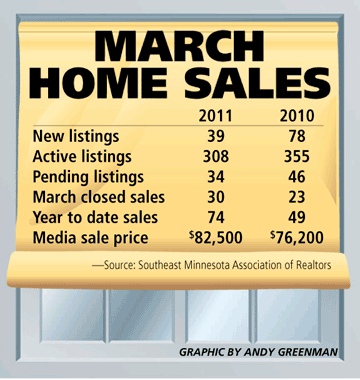Realtors: Home sales trending up
Published 11:13 am Friday, April 22, 2011
Things are looking up in the housing market.
After an extended downswing in the housing market, local real estate agents are optimistic the prime selling season of spring through fall will be strong in 2011.
“We are certainly recovering,” said Duane Sauke, owner of Austin’s Re/Max and board president of the regional Multiple Listing Service.
 That optimism is already translating to more sales in 2011. Seventy-four homes sold between January and March in Austin, which is a 51 percent increase from 49 by that time in 2010, according to numbers from the Southeast Minnesota Association of Realtors (SEMAR). In March, 30 homes sold compared to 23 last year.
That optimism is already translating to more sales in 2011. Seventy-four homes sold between January and March in Austin, which is a 51 percent increase from 49 by that time in 2010, according to numbers from the Southeast Minnesota Association of Realtors (SEMAR). In March, 30 homes sold compared to 23 last year.
The upturn isn’t just in the housing industry. Sauke said there’s been talk of small construction projects or expansions showing modest job growth. Such growth shows a more confident, positive job and housing market, according to Sauke.
“All these little changes show that there’s economic growth here in town,” he said.
Brian Blecker of Blecker Realty said the housing market has been stable, but sales aren’t necessarily balanced. Sales of high end homes have been slow, while homes marked at $150,000 or less have been selling more, he noted.
“We have maintained a pretty consistent number,” he said.
Blecker frequently works with foreclosed homes, and he said that market has remained steady.
“We have our fair share of the foreclosures,” Blecker said.
“I’m a very busy person right now,” he added.
Numbers comparing 2010 and 2011 don’t show the whole picture, according to Blecker, because the home buyer credit drove sales last spring.
Despite positive showings this year, it may be difficult to truly compare 2011 and 2010. Real estate agent Joe Fuhrman described last year’s numbers as “artificial” because of the home buyers’ credit, even though it did encourage sales.
“It worked well in Austin,” he said.
However, Sauke said the credit may not indicate more buyers over last year. While numbers were strong last spring with the credit expiring, sales lagged in summer and fall, Sauke said. It’s questionable how many new buyers the credit attracted. Rather, buyers may have just bought sooner than planned to take advantage of the credit, Sauke said.
Even when the housing market was at its lowest, Austin didn’t experience the significant ebbs and flows of other regions.
“We always do pretty well here,” Fuhrman said. “We have a much more stable economy than other places. We don’t have the highs and lows of other parts of the country.”
“Last year was a good year, and I think this year will be a good year, too,” he added.
With no credit for home buyers, Bleckers said it’s also difficult to qualify for a loan.
“They just have a lot higher standards than they did previously,” Blecker said.
Sauke said lenders haven’t necessarily tightened standards; they’ve just brought them back to past levels after they became more lax. Typically, a loan should be 30 percent or less of a family’s annual income, Sauke said.
However, Sauke said specific banks are still trying to set their credit benchmarks.
“That’s creating unsureness more than anything,” he said.
After fear kept people from buying, Sauke said he expects people may finally be ready to buy.
“It’s just been a long wait and people want to do something more now,” Sauke said.
A buyer’s market?
The housing market is ripe for buyers.
The market is still trending in favor of purchasers, but the interest rates are what’s really positive for potential home owners, according to Duane Sauke, board president of the regional Multiple Listing Service.
The interest rates are as low as they’ve been in decades at 4 to 5 percent, and Sauke said the rates will save buyers money over the long term.
“If they are capable and willing, they are going to get the best purchase that would have been experienced for years,” Sauke said.
From 2000 to 2006 when the housing market was stronger, interest rates were around 7 or 8 percent, according to Sauke. Rates were close to 12 percent in the 1980s.
Another positive for buyers: Many homes are selling at lower costs, according to multiple agents.





